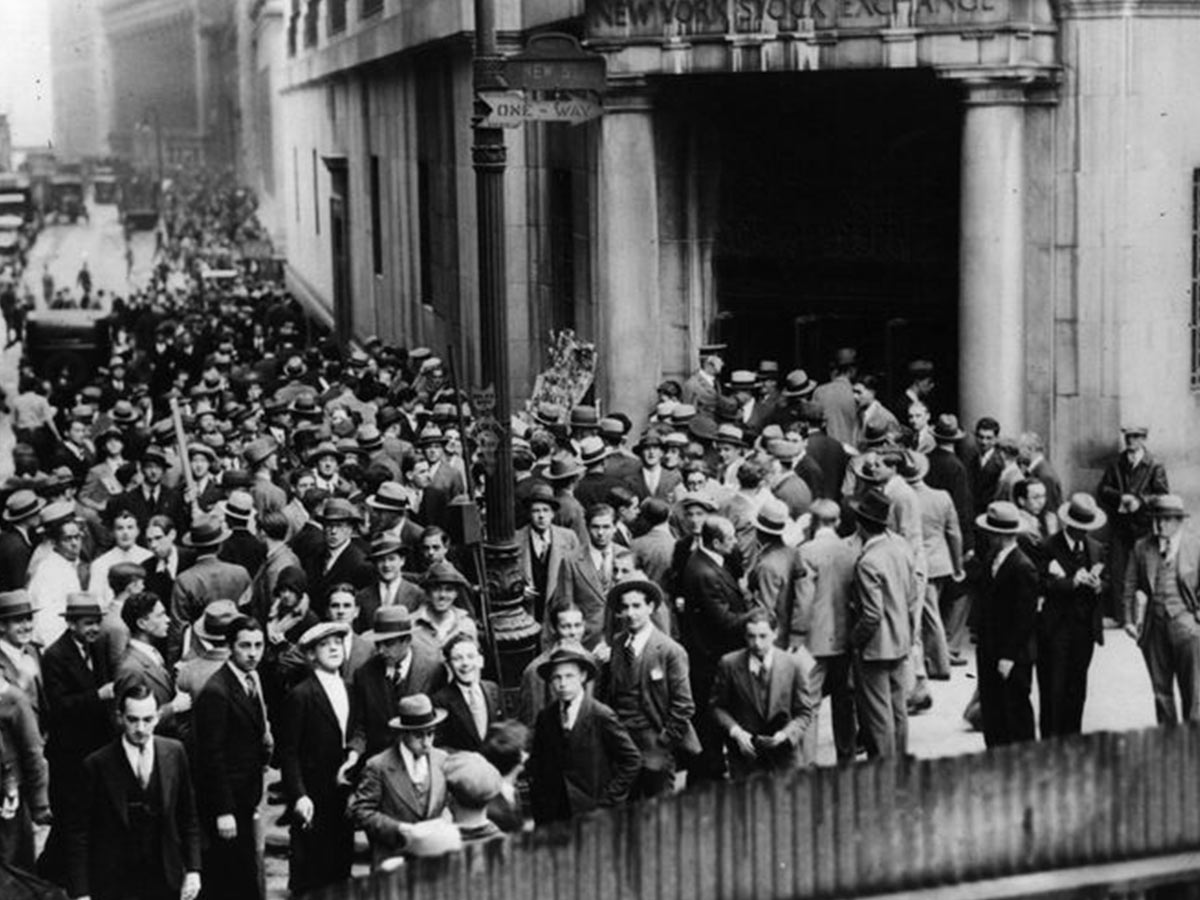Tulip Mania

Year: 1636-1637
Reason: Speculative trading of tulip bulbs
Resolution: Market collapsed, prices normalized
In the 17th century, the Dutch went wild for tulips — yes, the flowers. These vibrant blooms became the ultimate status symbol, and everyone from merchants to middle-class citizens wanted in. Prices skyrocketed, with some tulip bulbs costing more than an entire house. But what goes up must come down!
When the market realized paying a fortune for a flower might be... a tad much, panic set in, and prices plummeted overnight. The great "Tulip Mania" burst was one of history's first speculative bubbles, teaching an early lesson in the dangers of irrational exuberance. Though it left many financially bruised, the market eventually normalized, proving that even in 1637, there was no escaping the laws of supply and demand.
The South Sea Bubble

Year: 1720
Reason: Speculative frenzy over stock
Resolution: Government intervention, debt restructuring
In 1720, Britain was swept up in a frenzy over the South Sea Company, a business that promised unimaginable riches from trade with South America. People from all walks of life, from wealthy aristocrats to everyday citizens, eagerly bought shares, believing they’d found a path to instant fortune. The stock prices soared to outrageous levels, driven more by hype than reality.
But when profits failed to appear, the bubble burst, leaving many investors in ruins. The British government stepped in to stabilize the market by assuming much of the company’s debt and redistributing shares to more stable entities like the East India Company.
New regulations were also introduced, including the Bubble Act of 1720, aimed to prevent such speculative disasters in the future. Beware the glitter of “get-rich-quick” schemes, especially when there’s no treasure at the end of the voyage.
The Panic of 1873

Year: 1873
Reason: Bank failures and railroad collapse
Resolution: Suspension of bank payments, financial reforms
The Panic of 1873 hit with a force that echoed across continents, sparking what became known as the “Long Depression.”
Triggered by the collapse of Jay Cooke & Company, a major U.S. bank heavily invested in railroads, the panic spread like wildfire. When the bank declared bankruptcy, confidence in the financial system evaporated, leading to a wave of bank failures, stock market crashes, and widespread unemployment.
To stem the tide, the U.S. government suspended bank payments and halted construction on key infrastructure projects. Financial reforms slowly followed, aimed at stabilizing the banking sector and restoring faith in the economy. The Panic of 1873 was a stark reminder of how interlinked industries and institutions can trigger global financial turmoil.
The Panic of 1907

Year: 1907
Reason: Stock manipulation and bank runs
Resolution: J.P. Morgan’s intervention, Federal Reserve Act
The Panic of 1907 began with a failed attempt to corner the market on United Copper stock, which led to a chain reaction of bank runs and financial chaos. As panic spread, depositors rushed to withdraw their money, fearing their banks would collapse. With the financial system teetering on the edge, J.P. Morgan, the powerful financier, stepped in to coordinate a rescue.
He organized a group of bankers to provide emergency funds, stabilizing key institutions and stopping the panic. This crisis exposed the weaknesses in the U.S. financial system, prompting the creation of the Federal Reserve in 1913. The Panic of 1907 highlighted the need for a central bank to manage financial crises and safeguard the economy.
The Great Depression

Year: 1929-1939
Reason: Stock market crash and economic collapse
Resolution: New Deal policies, economic reforms
The Great Depression was a cataclysmic economic downturn that began with the stock market crash of 1929 and plunged the world into a decade of hardship. The crash wiped out fortunes, leading to massive unemployment, plummeting industrial production, and widespread poverty. Banks failed, businesses shuttered, and the global economy ground to a halt.
In response, President Franklin D. Roosevelt launched the New Deal, a series of ambitious programs and reforms aimed at recovery and reform. The New Deal introduced social safety nets (Social Security), regulatory changes (The SEC), and job creation initiatives (schools, roads, etc) gradually lifting the country out of the depression.
The Great Depression underscored the need for robust economic safeguards and government intervention to mitigate the effects of financial crises.
The Savings and Loan Crisis

Year: 1980s-1990s
Reason: Risky lending and regulatory failures
Resolution: Financial Institutions Reform, Recovery, and Enforcement Act (FIRREA)
The Savings and Loan Crisis unfolded over the course of the 1980s and 1990s, stemming from risky lending practices and regulatory oversight failures. Savings and loan associations (S&Ls), which were supposed to be conservative in their investments, engaged in high-risk ventures and real estate speculation.
When property values plummeted, many S&Ls faced insolvency, leading to a massive bailout. The government stepped in with the Financial Institutions Reform, Recovery, and Enforcement Act (FIRREA) of 1989, which restructured and closed failing institutions and revamped regulations to prevent future crises.
The resolution aimed to restore confidence in the financial system and introduce stricter oversight, serving as a critical lesson in the importance of regulatory vigilance.
The Asian Financial Crisis

Year: 1997-1998
Reason: Currency devaluations and financial mismanagement
Resolution: International Monetary Fund (IMF) intervention, economic reforms
The Asian Financial Crisis erupted in 1997, when several Asian economies, including Thailand, South Korea, and Indonesia, faced severe financial turmoil. The crisis began with the collapse of the Thai baht, which triggered widespread currency devaluations and a cascade of financial instability across the region.
Poor financial management and over-reliance on short-term foreign debt exacerbated the crisis. To stabilize the situation, the International Monetary Fund (IMF) intervened, providing emergency loans and pushing for economic reforms.
These included measures to strengthen financial institutions, improve transparency, and reform economic policies. The crisis highlighted the vulnerabilities of emerging markets and the critical role of international financial support in managing global economic shocks.
The Dot-Com Bubble

Year: 1995-2000
Reason: Overvaluation of internet-based companies
Resolution: Market correction, tech sector consolidation
The Dot-Com Bubble was a wild ride through the late 1990s, driven by exuberant investment in internet-based companies. As the web gained popularity, investors eagerly poured money into tech startups, often with little regard for profitability or business models. Stock prices of these "dot-com" companies skyrocketed to unsustainable levels, fueled by hype and speculation.
However, when many of these companies failed to deliver on their lofty promises, the bubble burst spectacularly in 2000. The ensuing market correction wiped out billions in investments and led to a wave of tech sector consolidations and failures. Despite the crash, the Dot-Com Bubble paved the way for the internet’s evolution, with surviving companies like Amazon and eBay emerging as giants in the digital age.
The 2008 Global Financial Crisis

Year: 2008
Reason: Subprime mortgage collapse and financial instability
Resolution: Bailouts, monetary easing, regulatory reforms
The 2008 Global Financial Crisis struck with devastating force, rooted in the collapse of the subprime mortgage market. Financial institutions, heavily invested in risky mortgage-backed securities, faced enormous losses as housing prices plummeted. This led to a cascade of bank failures and a severe credit crunch.
To stabilize the financial system, governments and central banks worldwide intervened with massive bailouts for banks, aggressive monetary easing, and unprecedented stimulus measures. In the wake of the crisis, significant regulatory reforms were enacted, such as the Dodd-Frank Act, aimed at increasing financial oversight and preventing future meltdowns.
The 2008 crisis underscored the interconnectedness of global finance and the crucial role of regulatory frameworks in maintaining economic stability.
The European Sovereign Debt Crisis

Year: 2010-2012
Reason: Excessive national debt and economic instability
Resolution: Bailouts, austerity measures, and financial reforms
The European Sovereign Debt Crisis emerged from a combination of excessive national debt and economic instability within the Eurozone. Countries like Greece, Portugal, and Ireland faced unsustainable debt levels, leading to fears of defaults and market turmoil.
To address the crisis, the European Union and the International Monetary Fund (IMF) stepped in with bailout packages, providing financial support in exchange for implementing austerity measures and economic reforms.
These measures aimed to restore fiscal stability and economic growth. The crisis led to significant changes in Eurozone governance and financial oversight, including the establishment of mechanisms like the European Stability Mechanism (ESM) to manage future economic pressures and ensure greater financial stability across member states.
 Author
Jennifer Freehill
Last Updated: March 23, 2025
Author
Jennifer Freehill
Last Updated: March 23, 2025

